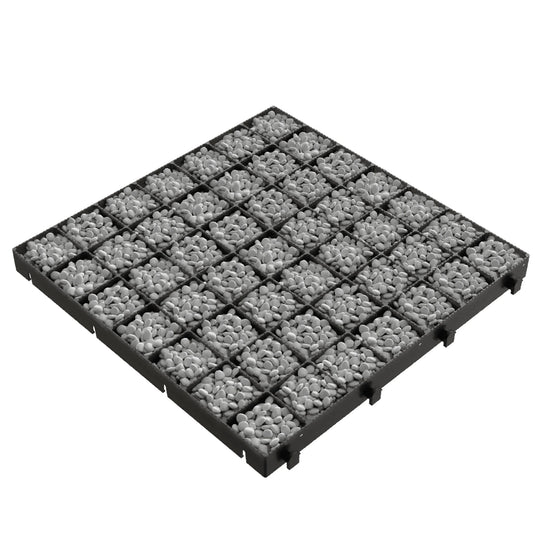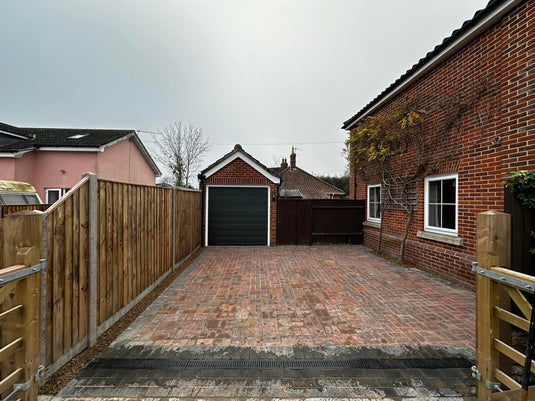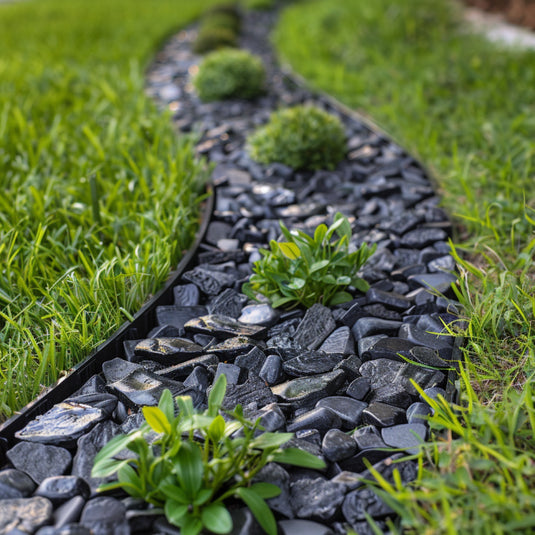This guide helps outline what materials you need to create a durable gravel driveway.
Just lay gravel straight down on the ground.
Well you could just put the gravel straight onto the ground with no preparation. That's certainly what homeowners have done for centuries. Throw the stone down and put some more down when the driveway starts to look a little bare.
Is it durable though? Can you really depend on a driveway that is essentially pebbled mud? Do you really want to maintain it, pull weeds out, replace the stone?
We don't want to labour on the point too much and we have already written a pretty comprehensive guide on how to lay a gravel driveway.
Perhaps you just want to know exactly what you need to buy to get the job done right? Use this shopping list to get exactly what you need. We've even included some rough pricing.
Equipment you'll need to lay a gravel driveway
Remember, we're doing the job right whilst not killing our backs (any more than is really necessary). With that in mind, you'll need to have these tools to hand:
- Mini-digger (or a spade if you want a good workout)
- A means to take away the excess soil - a grab lorry/skip/bulk waste bags
- A compactor "whacker plate"
- A jigsaw/reciprocating saw/circular saw
It's unlikely you've got a whacker plate on standby in your garage; it's even less likely you've got a mini digger parked up next to your SUV. Fortunately hiring these for a day or two is actually pretty reasonable price-wise. You can pick these up locally from a plant/tool hire company. Some builders merchants, such as Travis Perkins, have these covered.
Once you've dug the soil away to a depth of at least 210mm, you'll have produced a large amount of soil that you'll need to dispose of. Sometimes it works out cheaper to hire a grab lorry to take it away. Other times, you may be better putting it into a skip or bulk bags for collection.
Membrane, sub base, sand and gravel
Getting your sub base right is what makes the difference between an okay-for-now and a great, long lasting driveway. We've even written a simple guide that outlines how to lay a driveway sub base.
For your sub base level, you'll need to prepare a depth of at least 210mm which covers the depth of the sub base, sand, grids and stone overlay. For this you'll want to buy:
- Rolls of geotextile/membrane to line the bare ground, preventing the sub base sinking. Also to line the sand layer, preventing the gravel bedding in.
- 150mm of type 1/2/3 sub base - use our sub base calculator for volumes.
- 10mm of sharp sand to "blind" the sub base - use our sand calculator
- 80-120kg of gravel per square metre - use our gravel calculator
What do these materials and equipment cost?
Laying a gravel driveway is by far and away the cheapest driveway surfacing option of all. The only way to make it any cheaper would be to cut the sub base foundations, which in turn would undermine the strength and function of the driveway. We talk more about this in our post, "The true cost of gravel grids".
Below are some of the costs you might expect to pay for your gravel driveway, broken down by materials and equipment. Labour costs are determined by the contractors' gross profit requirements to run their business - something which we can't comment on.
| Item | Cost |
|---|---|
| Mini-digger | Around £150/day |
| Compactor/whacker plate | Around £40/day |
| Geotextile membrane | 86p per square metre (two layers) |
| Type 1/2/3 MOT sub base | Around £20-30 per square metre |
| Sharp sand | Around £1.50-1.80 per square metre |
| 20mm Angular Gravel | Around £8-10 per square metre |
| Gravel grids (recommended) | £10 per square metre |
With these costs all totalled together, you can expect to pay between £30-£55 per square metre for the materials for a gravel driveway.
Depending on your expertise, the size of your driveway and whether you use the recommended equipment, you would expect to spend between 30 minutes - 2 hours per square metre on installation.
How to stop your costs spiralling
With the pricing list outlined, it pays to make sure your sub base materials on site before your equipment arrives and the work begins. Your materials have fixed prices, not on a day/hourly rate. If you're waiting for the material to arrive, it will bring the work to a standstill, meaning the time and money spent on the rental and labour is going to waste.
This is why we always stress to order your sub base, your sand, membrane and gravel grids before even beginning to break ground. These foundational layers need to be on site and ready to go in the ground before the clock starts running on your hire and labour costs.
With easy to store materials such as gravel grids and membrane, it pays to order these materials to arrive at least a day before your contractors and/or plant arrive on site. Put these to one side, out of the way of the excavations.
Wasted time is the single biggest factor in spiralling costs. Whilst you think you're in control of a schedule, do what you can as early as your can to minimise relying on third parties sticking to that schedule.
Keep that in mind and your installation will go to plan, with no shocks when you look at the cost vs the budget.






